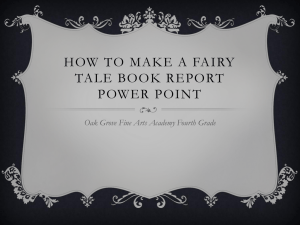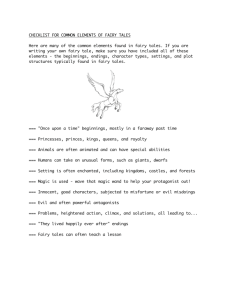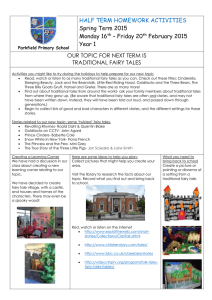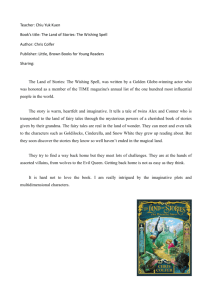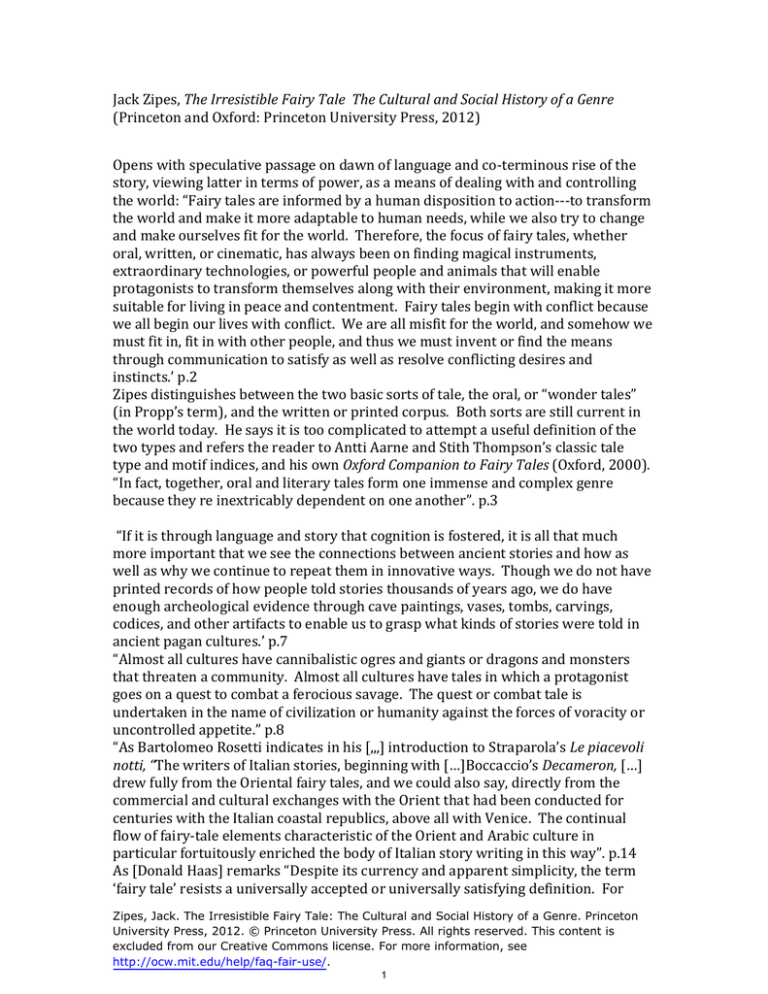
Jack Zipes, The Irresistible Fairy Tale The Cultural and Social History of a Genre
(Princeton and Oxford: Princeton University Press, 2012)
Opens with speculative passage on dawn of language and co-terminous rise of the
story, viewing latter in terms of power, as a means of dealing with and controlling
the world: “Fairy tales are informed by a human disposition to action---to transform
the world and make it more adaptable to human needs, while we also try to change
and make ourselves fit for the world. Therefore, the focus of fairy tales, whether
oral, written, or cinematic, has always been on finding magical instruments,
extraordinary technologies, or powerful people and animals that will enable
protagonists to transform themselves along with their environment, making it more
suitable for living in peace and contentment. Fairy tales begin with conflict because
we all begin our lives with conflict. We are all misfit for the world, and somehow we
must fit in, fit in with other people, and thus we must invent or find the means
through communication to satisfy as well as resolve conflicting desires and
instincts.’ p.2
Zipes distinguishes between the two basic sorts of tale, the oral, or “wonder tales”
(in Propp’s term), and the written or printed corpus. Both sorts are still current in
the world today. He says it is too complicated to attempt a useful definition of the
two types and refers the reader to Antti Aarne and Stith Thompson’s classic tale
type and motif indices, and his own Oxford Companion to Fairy Tales (Oxford, 2000).
“In fact, together, oral and literary tales form one immense and complex genre
because they re inextricably dependent on one another”. p.3
“If it is through language and story that cognition is fostered, it is all that much
more important that we see the connections between ancient stories and how as
well as why we continue to repeat them in innovative ways. Though we do not have
printed records of how people told stories thousands of years ago, we do have
enough archeological evidence through cave paintings, vases, tombs, carvings,
codices, and other artifacts to enable us to grasp what kinds of stories were told in
ancient pagan cultures.’ p.7
“Almost all cultures have cannibalistic ogres and giants or dragons and monsters
that threaten a community. Almost all cultures have tales in which a protagonist
goes on a quest to combat a ferocious savage. The quest or combat tale is
undertaken in the name of civilization or humanity against the forces of voracity or
uncontrolled appetite.” p.8
“As Bartolomeo Rosetti indicates in his [,,,] introduction to Straparola’s Le piacevoli
notti, “The writers of Italian stories, beginning with […]Boccaccio’s Decameron, […]
drew fully from the Oriental fairy tales, and we could also say, directly from the
commercial and cultural exchanges with the Orient that had been conducted for
centuries with the Italian coastal republics, above all with Venice. The continual
flow of fairy-tale elements characteristic of the Orient and Arabic culture in
particular fortuitously enriched the body of Italian story writing in this way”. p.14
As [Donald Haas] remarks “Despite its currency and apparent simplicity, the term
‘fairy tale’ resists a universally accepted or universally satisfying definition. For
Zipes, Jack. The Irresistible Fairy Tale: The Cultural and Social History of a Genre. Princeton
University Press, 2012. © Princeton University Press. All rights reserved. This content is
excluded from our Creative Commons license. For more information, see
http://ocw.mit.edu/help/faq-fair-use/.
1
some, the term denotes a specific narrative form with easily identified
characteristics, but for others it suggests not a singular genre but an umbrella
category under which a variety of other forms may be grouped. Definitions of ‘fairy
tale’ often tend to include a litany of characteristics to account for the fact the term
has been applied to stories as diverse as ‘Cinderella’, ‘Little Red Riding Hood’,
‘Hansel and Gretel,’ ‘Jack and the Beanstalk,’ ‘Lucky Hand’, ‘Bluebeard’, and ‘HennyPenny’”. p.22
Zipes continues “storytellers and writers never used the term ‘fairy tale’ until
d’Aulnoy coined it in 1697 […] it was not until 1750 that the term […] came into
common English usage […]” p.22 He goes on to look at the long oral and literate
tradition of fairy lore in French culture. He sees the genre as the creation of
aristocratic Frenchwomen writing in the later 17th and early 18th century, in a coded
protest against the inequalities of the patriarchal order of the ancien régime. pp.24-5
A deeply feminized world with strong influence from opera and ballet, p.26, and the
fairies acting as “magical midwives” p.37
We learn that the fairies are survivals of classical deities, and testimony to a strand
of underlying paganism that the church could never quite eradicate. He describes
d’Alene’s work as “protofeminist” p.34
Zipes severely criticizes Disney for his trivialization of character, dilution of intergenerational rivalry, and sexist male-orientated view of women: “to return to the
witch in the inane Disney film, we can see that the movie departs from the folk and
literary tradition, and that the witch/bitch is portrayed as one-dimensionally evil.
Following what Walt Disney did in his first animated feature film, Snow White and
the Seven Dwarfs (1936), his ‘modern’ corporation has followed suit by creating in
Tangled an aging woman who will deceive and destroy just to remain beautiful. She
is the pure incarnation of evil, [unlike, say, Baba Yaga, who can bless as well as
curse] and there is not just reason why she wants to kidnap Rapunzel except to
further her narcissistic desires. Obsessed with beauty and her [sic] own desires, the
Disney witches are stereotypical produces of the Western male gaze and massmediated manipulation of the images of women that date back to the Christian
church’s demonization of women.” p.78
“Witches and fairies are not the only significant female characters in fairy tales. In
fact, beautiful innocent maidens may be more important, but in the hands of male
tellers, writers, and collectors, they tend to be depicted as helpless, if not passive.
To be good, they must be obedient and industrious. The overwhelming number of
oral and literary fairy tales up through the nineteenth century usually stereotype
the young heroine, but this is not due to the demonization of women as deviants […]
It is because of a more general patriarchal view of women as domestics and
breeders, born to serve the interests of men.” p.80 He asserts that in the women’s
tradition, of which he produces several examples culled from forgotten collections
made and published by women, the female protagonists are much more assertive,
confident and courageous. He quotes examples from the editions of female writers
like Gonzenbach, Levesque, Busk, and Nemcova, which, despite the feminist revival
of the last third of the 20th century, continue to be overlooked.
Zipes, Jack. The Irresistible Fairy Tale: The Cultural and Social History of a Genre. Princeton
University Press, 2012. © Princeton University Press. All rights reserved. This content is
excluded from our Creative Commons license. For more information, see
http://ocw.mit.edu/help/faq-fair-use/.
2
MIT OpenCourseWare
http://ocw.mit.edu
21L.430 / CMS.920 Popular Culture and Narrative: Use and Abuse of the Fairy Tale
Fall 2015
For information about citing these materials or our Terms of Use, visit: http://ocw.mit.edu/terms.

